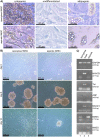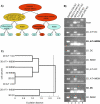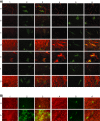Human spongiosa mesenchymal stem cells fail to generate cardiomyocytes in vitro
- PMID: 19903342
- PMCID: PMC2777841
- DOI: 10.1186/1477-5751-8-11
Human spongiosa mesenchymal stem cells fail to generate cardiomyocytes in vitro
Abstract
Background: Human mesenchymal stem cells (hMSCs) are broadly discussed as a promising cell population amongst others for regenerative therapy of ischemic heart disease and its consequences. Although cardiac-specific differentiation of hMSCs was reported in several in vitro studies, these results were sometimes controversial and not reproducible.
Results: In our study we have analyzed different published protocols of cardiac differentiation of hMSCs and their modifications, including the use of differentiation cocktails, different biomaterial scaffolds, co-culture techniques, and two- and three-dimensional cultures. We also studied whether 5'-azacytidin and trichostatin A treatments in combination with the techniques mentioned above can increase the cardiomyogenic potential of hMSCs. We found that hMSCs failed to generate functionally active cardiomyocytes in vitro, although part of the cells demonstrated increased levels of cardiac-specific gene expression when treated with differentiation factors, chemical substances, or co-cultured with native cardiomyocytes.
Conclusion: The failure of hMSCs to form cardiomyocytes makes doubtful the possibility of their use for mechanical reparation of the heart muscle.
Figures






Similar articles
-
Human embryonic and fetal mesenchymal stem cells differentiate toward three different cardiac lineages in contrast to their adult counterparts.PLoS One. 2011;6(9):e24164. doi: 10.1371/journal.pone.0024164. Epub 2011 Sep 9. PLoS One. 2011. PMID: 21931658 Free PMC article.
-
Differentiation of human adipose-derived stem cells into beating cardiomyocytes.J Cell Mol Med. 2010 Apr;14(4):878-89. doi: 10.1111/j.1582-4934.2010.01009.x. Epub 2010 Jan 11. J Cell Mol Med. 2010. PMID: 20070436 Free PMC article.
-
Trichostatin a promotes cardiomyocyte differentiation of rat mesenchymal stem cells after 5-azacytidine induction or during coculture with neonatal cardiomyocytes via a mechanism independent of histone deacetylase inhibition.Cell Transplant. 2012;21(5):985-96. doi: 10.3727/096368911X593145. Epub 2011 Sep 22. Cell Transplant. 2012. PMID: 21944777
-
Cardiomyogenic differentiation of human bone marrow mesenchymal cells: Role of cardiac extract from neonatal rat cardiomyocytes.Differentiation. 2010 Feb;79(2):93-101. doi: 10.1016/j.diff.2009.10.001. Epub 2009 Nov 18. Differentiation. 2010. PMID: 19926393
-
[Safety evaluation of tissue engineered medical devices using normal human mesenchymal stem cells].Yakugaku Zasshi. 2007 May;127(5):851-6. doi: 10.1248/yakushi.127.851. Yakugaku Zasshi. 2007. PMID: 17473528 Review. Japanese.
Cited by
-
Mesenchymal stem cells from umbilical cord tissue as potential therapeutics for cardiomyodegenerative diseases - a review.Int J Mol Cell Med. 2012 Summer;1(3):119-32. Int J Mol Cell Med. 2012. PMID: 24551768 Free PMC article. Review.
-
Effect of Rehmannia glutinosa Libosch extract on proliferation and cardiogenic pre-differentiation of human mesenchymal stem cells.Biomedicine (Taipei). 2022 Mar 1;12(1):39-52. doi: 10.37796/2211-8039.1243. eCollection 2022. Biomedicine (Taipei). 2022. PMID: 35836917 Free PMC article.
-
Fetal heart extract facilitates the differentiation of human umbilical cord blood-derived mesenchymal stem cells into heart muscle precursor cells.Cytotechnology. 2016 Aug;68(4):645-58. doi: 10.1007/s10616-014-9812-2. Epub 2014 Nov 7. Cytotechnology. 2016. PMID: 25377264 Free PMC article.
References
Publication types
MeSH terms
Substances
LinkOut - more resources
Full Text Sources

